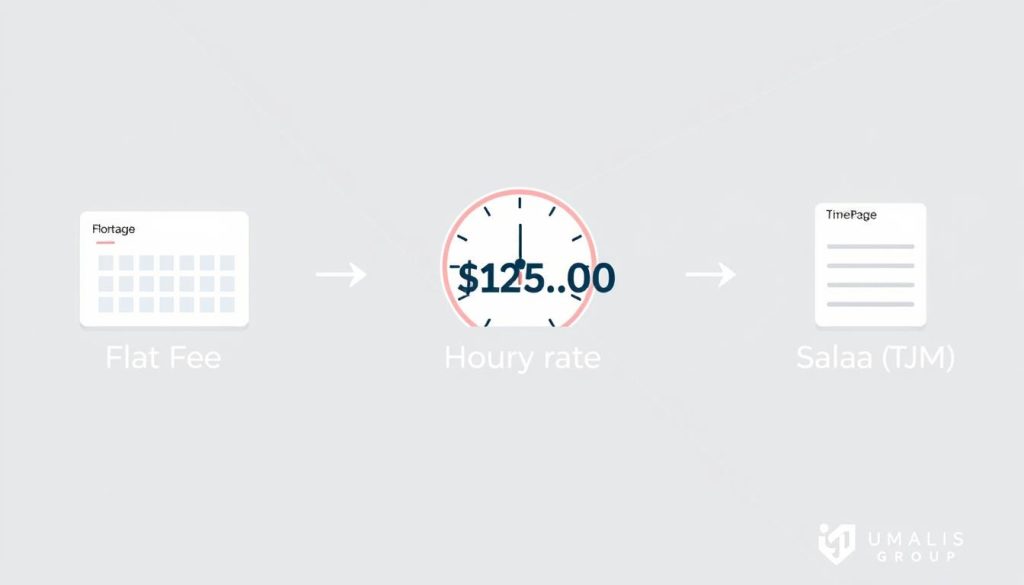Over 70% of independent professionals cite administrative tasks, especially invoicing, as their primary source of stress. This burden often distracts from their core mission and expertise.
Many consultants seek a solution that combines the freedom of freelancing with the security of traditional employment. This is where the portage salarial model becomes a powerful alternative.
This framework fundamentally changes the billing process. The société portage you partner with takes on all facturation responsibilities. They handle client invoicing, legal requirements, and payment follow-up on your behalf.
As a salarié porté, you are freed from complex administrative obligations. You can focus entirely on delivering value to your clients. This guide will walk you through the secure invoicing process within this system.
We will explain the three-party relationship between you, your client, and the entreprise portage salarial. Our goal is to provide clarity and peace of mind, ensuring your financial operations are both streamlined and protected.
Table of Contents
Key Takeaways
- Portage salarial eliminates the administrative burden of invoicing for independent professionals.
- The portage company manages all aspects of facturation, including legal compliance.
- This model allows the consultant to focus solely on their professional missions.
- A clear three-party relationship defines the invoicing process between the salarié, client, and société.
- Choosing this path provides financial security and administrative peace of mind.
Understanding Portage Salarial and Its Advantages
Originating in the 1980s, the portage salarial system was designed to resolve the core dilemma faced by independent workers: freedom versus security. This innovative framework creates a formal three-party relationship that redefines independent work.
It connects you, the client, and the société de portage. This structure provides a solid foundation for your professional activité.
What is Portage Salarial?
This model establishes you as a salarié of the entreprise portage. You are an employee for administrative and legal purposes.
Yet, you retain full control over your professional travail. You find your own missions and manage your client relationships. The portage company acts as your official employer, handling the complex backend operations.
Administrative Ease and Social Protection Benefits
The primary benefit is immediate administrative relief. The société manages all legal and financial paperwork. This includes invoicing, tax declarations, and social contribution payments.
You gain access to full sécurité sociale benefits. This comprehensive protection covers health insurance, retirement plans, and unemployment benefits. It offers peace of mind that is rare for self-employed travailleurs.
| Your Role as a Consultant | Role of the Portage Company |
|---|---|
| Secure and manage client missions | Prepare and manage employment contracts |
| Focus on delivering expert work | Handle all client invoicing and payment collection |
| Negotiate your professional fees | Manage salary payments and social contributions |
This clear division of labor allows you to concentrate on your expertise. You build your career with the safety net of traditional employment.
Essential Steps to Establish Your Billing Process
The journey to secure invoicing starts with careful mission definition and client alignment. This foundational phase ensures smooth financial operations throughout your engagement.
Defining Your Mission and Contractual Terms
As a consultant, you begin by securing opportunities that match your expertise. The initial négociation phase involves direct discussions about scope, deliverables, and working modalités.
You establish clear parameters for your prestation, including location, duration, and specific objectives. This clarity prevents misunderstandings later in the process.
Once terms are agreed upon, your société portage formalizes the arrangement through official contrat documents. They ensure all conditions are properly documented.
Setting Expectations with Your Client
Clear communication with your entreprise cliente about payment modalités is essential. Discuss whether you’ll use partial payments, monthly billing, or completion-based payments.
Setting realistic expectations about your availability and the temps required for deliverables ensures smooth mission execution. This professional approach builds trust and prevents disputes.
| Consultant Responsibilities | Client Expectations | Portage Company Role |
|---|---|---|
| Define mission scope and objectives | Clear deliverables and timelines | Contract formalization and legal compliance |
| Establish working modalities and availability | Payment terms and schedule alignment | Financial optimization and relationship management |
| Negotiate professional fees and terms | Quality standards and communication protocols | Administrative support and payment processing |
This structured approach to establishing your billing process creates a solid foundation for successful collaboration. Your société portage supports you every step of the way.
Exploring Different Billing Methods in Portage Salarial

Selecting the right billing method is a critical decision that directly impacts your financial planning and client relationships. This framework offers flexibility, allowing you to choose a tarif structure that best reflects the nature of your prestation.
We will guide you through the three primary options available. This ensures you can confidently set your honoraires for various missions.
Daily Rate (TJM), Hourly Rate (THM), and Flat Fee Options
The taux journalier moyen (TJM) is the most common approach. It defines your daily rate excluding taxes. This provides clear cost expectations for multi-day projects.
Calculating your taux journalier involves assessing your expertise, market rates, and desired net income. For instance, billing 15 jours to achieve a specific revenue goal determines your necessary tjm.
For shorter engagements, the taux horaire moyen (THM) is practical. It is derived by dividing your journalier moyen by a standard eight-hour day. This taux is ideal for consultations or brief advisory sessions.
The flat fee, or forfait, method values deliverables over time. You set a fixed montant for a complete prestation, like a workshop or audit. This approach focuses on the value of the result.
Your partner company assists in selecting the optimal method for each mission. They help ensure your tarif is both competitive and covers all necessary costs, securing your financial stability.
How Invoices Are Managed and Processed
Understanding the flow from client payment to your personal salary provides clarity on the financial security this model offers. The systematic facturation process ensures every step is handled professionally, eliminating administrative concerns from your responsibilities.
Invoice Creation and Dispatching
Once your mission reaches completion, your société portage assumes complete responsibility for facture creation. They base each document on your service contract, incorporating agreed terms and billing methods.
You submit a monthly activity report declaring actual working time. This ensures accurate facturation reflecting work performed. The entreprise portage then dispatches professionally formatted invoices with all legal requirements.
Payment Reception and Salary Attribution
Your client processes paiement by transferring funds to the portage company’s compte. Upon réception, the gestion process transforms your chiffre affaires into salary.
The company first deducts management fees, typically around 7% of turnover. The remaining amount undergoes calculations for social contributions. Your net salaire is then deposited into your personal account with detailed documentation.
If paiement delays occur, your société portage handles recovery procedures. This protects you from chasing unpaid invoices while maintaining professional client relationships.
Navigating Financial Requirements and Calculations

Understanding how your billed revenue transforms into take-home pay empowers informed business decisions. This clarity ensures your financial planning aligns with both legal requirements and personal goals.
Incorporating Charges, Fees and Social Contributions
Your invoiced amount undergoes several déductions before reaching your account. Social cotisations represent approximately 50% of turnover, funding comprehensive protection including health insurance and retirement benefits.
Management frais typically account for 7% of your chiffre d’affaires. These charges cover administrative support, legal compliance, and payment processing services.
Professional frais like travel or equipment can be reimbursed separately. Submit documentation to your partner company for tax-free reimbursement.
Ensuring a Minimum Viable Salary
The collective agreement establishes minimum rémunération thresholds based on experience. For 2024, these range from 2,704.8€ to 3,284.4€ gross monthly.
To meet these requirements, monthly billing should typically exceed 4,000€ HT. Our detailed remuneration calculation guide helps determine your necessary daily rate.
Realistic planning accounts for non-billable days. While 218 working days exist annually, targeting 180 billable days ensures your salaire net meets both legal minimums and personal objectives.
Mastering the Process: comment facturer en portage salarial Effectively
The art of pricing your services combines analytical market research with confident self-assessment of your unique capabilities. This approach ensures your financial strategy aligns with both market realities and professional aspirations.
Step-by-Step Guidelines for Securing Your Invoices
Begin with comprehensive market analysis. Understand sector trends and client needs through specialized publications and professional networking. This foundation informs your pricing strategy.
Analyze competitor positioning and service offerings. Avoid aligning with the lowest market prices that could devalue your expertise. Instead, focus on establishing rates that reflect your unique value proposition.
Adapt your approach to different client budgets. A multinational corporation’s resources differ significantly from a growing SME’s capabilities. Maintain a firm minimum daily rate threshold during negotiations.
Remember that social contributions represent approximately 50% of your invoiced turnover. This essential security funding distinguishes the employment model from other independent work arrangements.
Value your competencies and professional background effectively. Clients invest in accessing high-level problem-solving capabilities, not merely task completion. Your specialized training and proven track record justify premium pricing.
Prepare compelling justifications for your rates. Articulate concrete benefits and measurable ROI your services deliver. Mission duration and strategic importance should influence your final pricing decisions.
Your partner organization provides valuable guidance throughout this process. They offer market rate insights and handle all administrative steps once terms are agreed, allowing you to focus on delivering exceptional client work.
Conclusion
Choosing the right partner for your professional journey is the final, crucial step in securing your independent career. This employment model transforms administrative complexity into streamlined gestion, allowing you to focus entirely on your core activité.
As a salarié within this framework, you gain comprehensive sécurité while maintaining control over your missions. Your partner société handles all financial operations from invoice creation to salary distribution into your compte.
The transparent modalités ensure your chiffre d’affaires converts to regular salaire with predictable rémunération. This statut provides the stability needed for long-term professionnel growth.
We encourage exploring how this innovative entreprise solution can support your ambitions. The peace of mind and recovered temps create the foundation for sustainable success in your independent activité.
FAQ
What is the difference between my turnover and my net salary in a portage salarial arrangement?
Your turnover, or chiffre d’affaires, is the total amount you invoice your client for your services. From this amount, the portage company deducts its management fees, employer social contributions, and professional expenses. The remaining balance is your gross salary, from which employee social charges are then subtracted to arrive at your final net salary.
How do I calculate my daily rate (Taux Journalier Moyen) to ensure a viable income?
To determine your TJM, start with your desired net monthly salary. Add all social charges (both employer and employee portions), the portage company’s management fees, and an estimate for your professional expenses. Divide this total by the number of billable days you plan to work per month. This calculation ensures your rate covers all costs and leaves you with a sustainable salary.
Who is responsible for creating and sending invoices to the client?
The portage salarial company handles the entire invoicing process. You provide them with the details of your mission, including the agreed-upon rate, number of days worked, and the client’s information. They then generate a professional invoice on your behalf, dispatch it to the client, and manage the follow-up for payment, streamlining your administrative tasks.
What happens after the client pays the invoice?
Once the portage company receives payment from your client, they begin the salary attribution process. They deduct their agreed-upon management fees and pay all required social security contributions on your behalf. The remaining funds are then processed as your gross salary. You receive a detailed payslip, just like a traditional employee, showing your net pay after employee deductions.
Can I deduct professional expenses, and how does that work?
Yes, you can deduct legitimate professional expenses. These are costs directly related to your activity, such as travel, equipment, or training. You provide supporting documents (receipts) to your portage company. These expenses are deducted from your turnover before social charges are calculated, which can positively impact your net remuneration.
How long does it typically take to receive my salary after submitting a timesheet?
The timeline depends on the portage company’s specific payment terms and your client’s payment schedule. Generally, after you submit your validated timesheet, the company invoices the client. Once the client pays the invoice (often on 30-day terms), the company processes your salary. Most companies have a set payroll date each month, so the entire process can take several weeks from the end of your work period.





